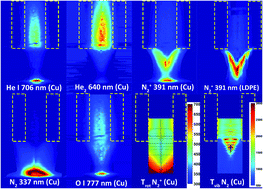Radially resolved optical emission spectral imaging study of an atmospheric pressure μDBD jet for elucidating the effect of sample surface material on the underlying mechanisms†
Abstract
Dielectric barrier discharges are receiving increasing attention as sampling/ionization sources for ambient mass spectrometry. Nevertheless, the underlying mechanisms are not completely understood, particularly when the plasma plume is exposed to a sample surface. Herein, an atmospheric pressure helium micro-dielectric barrier discharge (μDBD), flowing into open-air and onto a sample surface (floating Cu or LDPE), is studied via optical emission spectroscopy (OES) with radial information extracted through Abel's inversion. Radially resolved optical emission profiles along the axis are shown to shift with respect to the line-of-sight counterparts, for some species. The OES images, as well as vibrational and rotational temperature maps, indicate the energy transfers mainly via Penning ionization of N2 with He metastables to produce N2+, as the plasma plume exits the capillary into open air, while charge transfer with He2+ is dominant further downstream, as well as toward the periphery of the plume. In addition, the sample surface is shown to play an important role in the energy transfer mechanisms. For the LDPE sample, the spatial distribution sequence of excited species is similar to the free-flowing counterpart but disappears into the surface, which indicates that excited N2 further downstream/outer periphery is produced from electron recombination with N2+. On the other hand, the presence of the floating Cu sample results in an intensity peak at the plasma/surface interface for most species. We propose that the temporal evolution of the half-cycle dynamics have a great effect, where the resulting higher electron temperature and density towards the surface of metallic samples favors electron impact excitation. Furthermore, profilometry of the resulting craters in the floating Cu samples revealed a close correlation between their diameter and the width of the N2+ emission.



 Please wait while we load your content...
Please wait while we load your content...